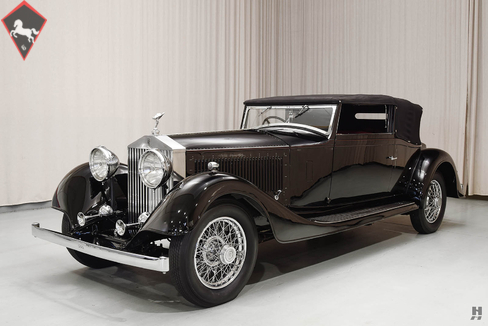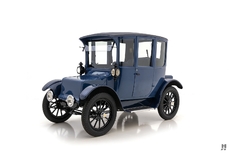Rolls-Royce Phantom II Drophead 1930
General description :
Between 1929 and 1935, the magnificent Phantom II sat atop the Rolls Royce range. Serving as a replacement for the original Phantom, the Phantom II was completely redesigned from the ground up, and shared very little in common with its predecessor beyond the bore and stroke dimensions of the 7,668cc inline six-cylinder engine. Engineers made a great deal of progress within the big six; with a cross flow cylinder head, separate inlet ports, improved exhaust manifold and a bump in compression finding an additional 20hp. The driveline was also improved with modifications to the gearbox and clutch and the addition of a Hotchkiss drive layout for the hypoid rear axle which allowed for a lower floor line. This of course delighted coachbuilders who could now fit ever sportier and sleeker bodywork. Performance was exceptional for a car of this size, and sales proved strong considering the price, with 1,767 built over a seven year run. Of course, Rolls Royce was never one to rest on its laurels, so over sixty running changes were made during the course of production to further refine and enhance the Phantom II.
In the early 1920’s, the President of Brazil suggested to his wealthy friend Octavio Guinle that Rio de Janeiro needed a world class beachfront hotel. Guinle took up the challenge and hired French architect Joseph Gire to design a fabulous new building. The Copacabana Palace, as it would become known, was built to be the very best and it soon became a destination for royalty, Hollywood stars, and the social and business elite of the world. In the late 1920s, his hotel a rousing success, the time came for Guinle to order a new automobile and he looked no further than Rolls-Royce’s new flagship, the Phantom II. An aficionado of French design, Guinle turned to one of Paris’ most exclusive coachbuilders, Henri Binder, to supply the bodywork. Binder was well established as a constructor of high-quality coach bodies, and successfully transitioned to automobile bodies at the turn of the century. Binder bodies were traditionally very stylish and exceptionally well-constructed, usually gracing big, powerful chassis from Minerva, Delage, Cadillac, and even one of the six majestic Bugatti Type 41 Royales. Guinle’s Phantom II (wearing chassis number 103GY) was sold through Oscar A. Cox & Co. of London, and was delivered to Binder on July 31st of the same year. After completion of the dramatic drophead coupe body, it was shipped to Rio where it remained in Guinle’s possession until 1938. Subsequent owners included Mr. W.D. Radcliffe of Liverpool, B. Stinton Johnson of Stretton Hall, Cheshire from 1947-1950 and Neil Tuson of London. It then found its way to the United States where it was featured in several prominent collections including Bill Lassiter, The Blackhawk Collection, the Imperial Palace Collection and then finally with Dr. Donald Vestley who took the opportunity to restore this beautiful machine in 1986.
Under the guidance of Mr. Vestley, 103GY underwent a comprehensive restoration. Coincidentally, Vestley had another PII, chassis number 162SK, in his possession. 162SK was a fully restored, bare chassis and one of the very late production cars that had benefited from the refinements made by Rolls Royce. 162SK was originally delivered wearing formal Sedanca deVille coachwork by Windovers but that body had long been separated with the chassis. It was decided that the restored body and engine of 103GY would be mated to the improved long-wheelbase 162SK chassis. Now, the magnificent Binder Drophead bodywork rode on a chassis that featured more refined suspension, central lubrication and improved handling, making it an ideal choice for drivers.
Today, 162SK presents in lovely condition, painted black with a matching fabric roof, offset by a subtle red pinstripe to compliment the striking red interior. The Binder coachwork is long, sleek and sexy, with a unique dropping rear body line and a low-slung three-position Victoria-style roof. Dual rear-mount spares keep the body sides clean and help make the body look even longer and lower. A useful trunk is integrated into the rear bodywork, fitting nicely between the rear wings. The black paintwork suits the spectacular lines and presents in good condition, showing some age in places but keeping a handsome patina overall. The red leather cabin is similarly patinated but very inviting and usable. The engine compartment is tidy and very presentable, the massive “six” having been overhauled in 2000 and remaining quite strong today.
It is not uncommon for pre-war Rolls-Royce motorcars to wear several different bodies in their lifetime. What makes 162SK special is the combination of comprehensive and interesting history, the magnificent sporting coachwork and a wonderfully sorted late-specification chassis. Rarely do we find a Phantom II with such special coachwork that is also an outstanding driver; its mechanical and cosmetic condition making it a simply jaw-dropping RROC or CCCA tour car.
http://hymanltd.com/vehicles/5567-1930-rolls-royce-phantom-ii-drophead/
1930 Rolls-Royce Phantom II Drophead is listed sold on ClassicDigest in St. Louis by Mark Hyman for $475000.
Car Facts
Car type : Car Make : Rolls-Royce Model : Phantom II Model Version : Drophead Engine size : 0.0 Model Year : 1930 Location : Missouri
Sold
Seller Information
Sold
People who viewed this Rolls-Royce Phantom II also viewed similar Rolls-Royce listed at ClassicDigest
Other cars listed for sale by this dealer
About Rolls-Royce
Well, ladies and gentlemen, today we're diving into the illustrious history of a brand that has always embodied the very essence of British luxury and craftsmanship - Rolls-Royce.Our story begins at the turn of the 20th century when two visionaries, Charles Rolls and Henry Royce, decided to join forces. In 1904, the very first Rolls-Royce was born, the Rolls-Royce 10 hp. It was a modest start for a company that would go on to redefine automotive excellence.
But it wasn't until 1907 that Rolls-Royce truly made its mark with the introduction of the Silver Ghost. It was hailed as the "Best Car in the World" and set the gold standard for luxury motoring. With its whisper-quiet engine and exquisite craftsmanship, it was a statement of opulence and refinement.
The 1920s brought us the Rolls-Royce Phantom I, an icon of its time. It was the first Rolls-Royce to feature a 6-cylinder engine and set the stage for the legendary Phantom line. This was the era when the Maharajas of India commissioned custom-bodied Rolls-Royces that were nothing short of automotive palaces.
Fast forward to the post-war years, and we have the Silver Cloud, a symbol of post-war British optimism. The Silver Cloud was elegance personified, with its flowing lines and handcrafted interiors. It was the choice of royalty, celebrities, and captains of industry.
But if we're talking about the epitome of Rolls-Royce luxury, it's the Rolls-Royce Phantom VI, which graced us with its presence from 1968 to 1991. This was a car that made the statement that "if you have to ask the price, you can't afford it." Customization was the name of the game, and the Phantom VI was a canvas for the world's wealthiest to express their unique tastes.
Now, it's impossible to discuss Rolls-Royce without mentioning the Rolls-Royce Corniche. Produced from 1971 to 1995, it was a convertible and coupe version of the Silver Shadow. The Corniche was the quintessential grand tourer, a car for those who wished to traverse continents in absolute luxury.
But, alas, even the mightiest must face their decline, and Rolls-Royce was no exception. The company went through financial turmoil in the 1970s and 80s, leading to the takeover by Vickers plc. Then came the controversial BMW and Volkswagen ownership period, which divided enthusiasts.
Rolls-Royce regained its footing under BMW ownership, and the new millennium brought us the Rolls-Royce Phantom VII, a return to the company's roots of uncompromising luxury. The Phantom VII was a testament to British engineering and craftsmanship.
And that, ladies and gentlemen, brings us to today. Rolls-Royce continues to produce some of the most opulent, bespoke vehicles on the planet, a symbol of British imperiousness that has not waned with time. The spirit of Sir Henry Royce and Charles Rolls lives on in every car that bears the Spirit of Ecstasy, a testament to the enduring legacy of British automotive excellence.











